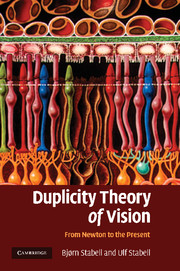Book contents
- Frontmatter
- Contents
- Acknowledgements
- 1 Introduction
- Part I The development of the basic ideas of the duplicity theory from Newton to G. E. Müller
- Part II The development of the duplicity theory from 1930–1966
- 6 The duplicity theory of Polyak
- 7 Investigations of H.K. Hartline and S.W. Kuffler
- 8 The duplicity theory of R. Granit
- 9 Contributions of E.N. Willmer, P. Saugstad & A. Saugstad, and I. Lie
- 10 Status of the duplicity theory in the mid 1960s and its further development
- Part III Chromatic rod vision: a historical account
- Part IV Theories of sensitivity regulation of the rod and cone systems: a historical account
- Part V Factors that triggered the paradigm shifts in the development of the duplicity theory
- References
- Index
10 - Status of the duplicity theory in the mid 1960s and its further development
Published online by Cambridge University Press: 22 January 2010
- Frontmatter
- Contents
- Acknowledgements
- 1 Introduction
- Part I The development of the basic ideas of the duplicity theory from Newton to G. E. Müller
- Part II The development of the duplicity theory from 1930–1966
- 6 The duplicity theory of Polyak
- 7 Investigations of H.K. Hartline and S.W. Kuffler
- 8 The duplicity theory of R. Granit
- 9 Contributions of E.N. Willmer, P. Saugstad & A. Saugstad, and I. Lie
- 10 Status of the duplicity theory in the mid 1960s and its further development
- Part III Chromatic rod vision: a historical account
- Part IV Theories of sensitivity regulation of the rod and cone systems: a historical account
- Part V Factors that triggered the paradigm shifts in the development of the duplicity theory
- References
- Index
Summary
At the end of the mid-twentieth century period (1930–1966), spectrophotometric measurements of spectral absorption in single photoreceptors had conclusively demonstrated that the retina contained three different types of cone, each cone with only one photopigment, together with the rods that contained only rhodopsin. Hence, it had been proved that the speculative idea of König (1894) and Willmer (1946, 1961) that rods may function as the primary ‘blue’ receptor, Willmer's and Granit's ideas of 'day rods', Polyak's idea that the trichromacy of colour vision was based on three types of bipolar cell, and the dominator-modulator theory of Granit, were all wrong. Moreover, Lie (1963), in his important and comprehensive study, had found that rods under scotopic test conditions mediated achromatic colour sensations only, and that under mesopic test conditions they contributed an achromatic component, desaturating the chromatic cone component.
Apparently, with the exception of the idea of rod-cone interaction, the duplicity theory had become strikingly similar to the old, orthodox conceptions formulated by von Kries (1929).
ELABORATION AND REVISION OF THE TWO MOST BASIC ASSUMPTIONS OF SCHULTZE'S DUPLICITY THEORY
As can be seen, the developmental history of the duplicity theory in the 100 years between 1866 and 1966 may be characterized by complex and comprehensive theory constructions. Outstanding examples are the theories provided by Schultze (1866), Parinaud (1881, 1885), König (1894), von Kries (1929), G. E. Müller (1930), Polyak (1941), Granit (1947, 1955) and Willmer (1946, 1961).
Information
- Type
- Chapter
- Information
- Duplicity Theory of VisionFrom Newton to the Present, pp. 105 - 107Publisher: Cambridge University PressPrint publication year: 2009
